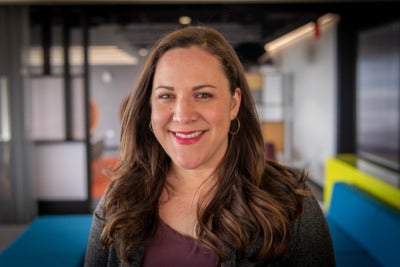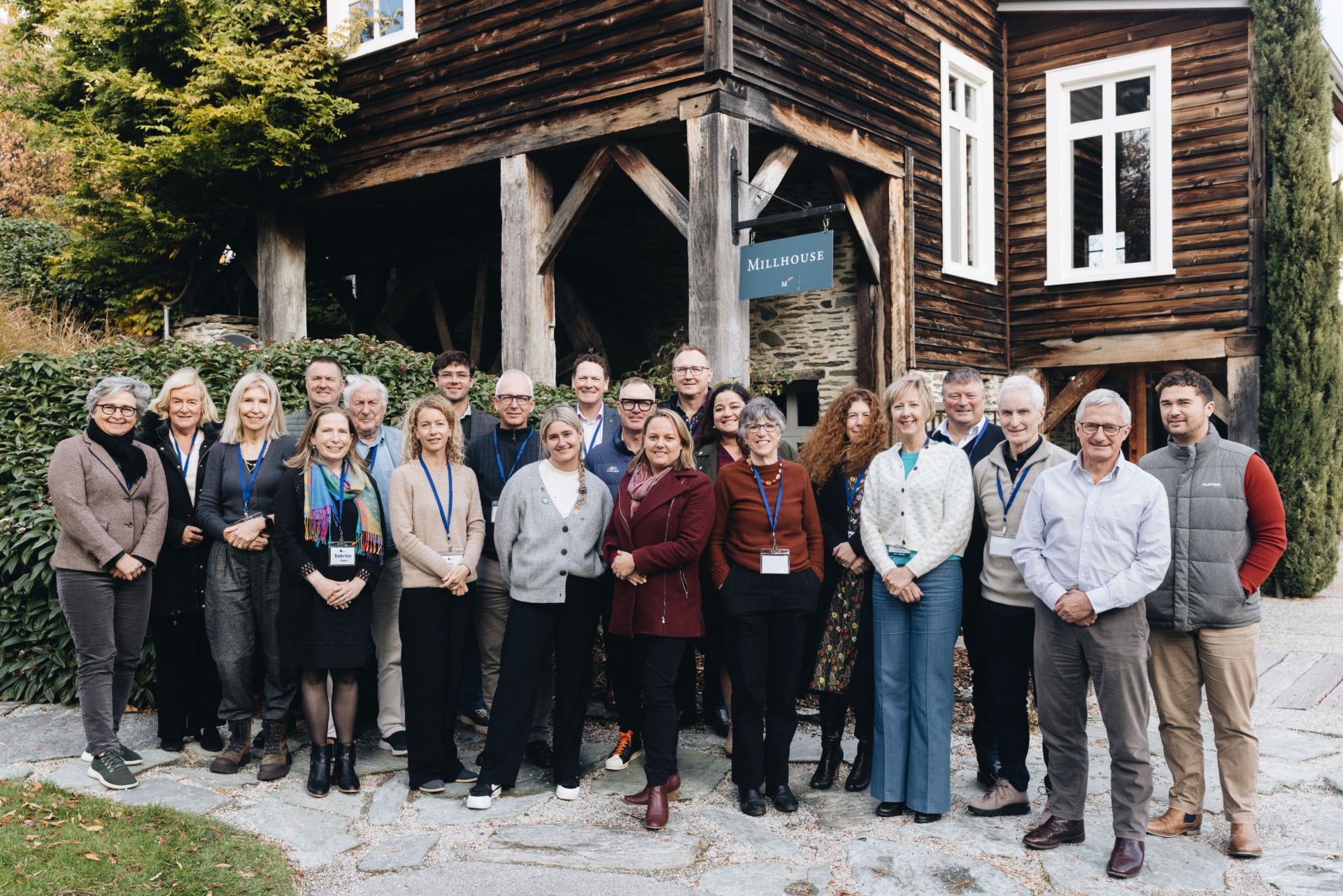Economic inequality has been increasing in the U.S. almost continuously since 1980, resulting in the most unequal distribution of wealth among industrialized countries. If that’s ever going to change, business leaders must play a role in the solution. Inequality may be more commonly seen as the domain of the public or philanthropic sector, but the private sector has immense influence—from employment practices, to the products and services they sell.
The Aspen Institute Business & Society Program launched the Economic Mobility Fellowship in 2023 to support passionate and innovative leaders working from within business to address the risks of growing inequality and build pathways for greater economic stability, mobility and wellness for low-income individuals and marginalized communities.
 We recently sat down with one of the 14 Fellows of the inaugural cohort to discuss what the work looks like and gather some of the insights she’s learned along the way. Lindsay Aleshire is the SVP and Social Sustainability Lead in the Office of Sustainability at M&T Bank and knows the importance of storytelling to capture impact and drive further change.
We recently sat down with one of the 14 Fellows of the inaugural cohort to discuss what the work looks like and gather some of the insights she’s learned along the way. Lindsay Aleshire is the SVP and Social Sustainability Lead in the Office of Sustainability at M&T Bank and knows the importance of storytelling to capture impact and drive further change.
The word “sustainability” may call to mind environmental themes, but, says Lindsay, “At M&T, we define Social Sustainability as encompassing anything that creates long-term strategic value for our employees, customers, and community members.” She continues: “Some other organizations may call this Corporate Purpose or Social Impact. For a large financial institution like M&T, being socially sustainable means attracting, retaining, and developing the right talent for our organization; ensuring diversity at all levels of our organization and across our customer base; and financing an equitable economy within the communities we serve.”
A key challenge in this role is managing the short-term financial pressures and long-term value creation, which some have argued is a major driver of inequality in the U.S. So, how can a financial institution change that dynamic? We caught up with Lindsay just as she was wrapping up M&T Bank’s 2023 Sustainability Report, a large part of her expansive role—and an indicator of the centrality of storytelling and narrative as key strategies in her toolkit for social change.
You’re Senior Vice President and Social Sustainability Lead in the Office of Sustainability at M&T Bank. What does that role entail, and what are you focused on now?
As the head of Social Sustainability at M&T Bank, I lead strategy creation, measurement and reporting, and stakeholder management for social sustainability across the organization.
My role is as a connector, bringing together many internal stakeholders to align under one strategy; an advisor, looking at current sustainability trends and benchmarking as an indicator of how our organization should be adapting to changing conditions; and an accountability partner, measuring progress across the organization and holding stakeholders accountable to our shared strategy and goals.
I’m also working on a few strategic projects, including aligning workforce development efforts across the organization to create sustainable, equitable talent pipelines in our communities, and a conducting an analysis to assess the organization’s’ initiatives, programs, products, and services for racial equity and inclusiveness.
How do you see your role as intersecting with levers for growing economic opportunity in the US?
Growing economic opportunity is critical to our success as an organization, and especially as a financial institution. Our business model depends on whether people have money to spend, or credit to build their businesses, or the right tools to build personal wealth. Our success is deeply intertwined with our communities’ success; that is, to the extent that our communities have thriving economies, our organization will be successful.
That said, banks like M&T have a huge role to play in creating economic opportunity. Our products and services give people the tools they need to plan, save, borrow, and spend money, which help determine a person’s financial wellness. The more people who have access to the financial system, the more economic opportunity we will see. We also leverage capabilities like affordable housing, philanthropy, small business development, and access to capital to create economic opportunity in our communities.
Where my role (and the work of many of my internal and external partners) comes in to play is in setting the organization up for long-term success by balancing short-term and long-term priorities. Growing revenue by servicing profitable customers will always be important to us, but so too should serving a diversity of customers within our community and increasing access to our products and services, even for members of the community who may not be profitable customers immediately. By serving many types of customers, we are creating a sustainable customer base and a sustainable business model.
Making social sustainability a strategic advantage means balancing short-term, immediate wins with longer-term measures for success (like diverse customer growth and wealth-building).
What have you found most challenging about this work? And/or what gives you hope?
This tension between short-term and long-term measures of success is definitely one of the most challenging parts of the work. Most organizations are built to respond to our financial markets, which value net income and earnings per share, among other short-term financial metrics.
What is also crucial to our success is how we are investing for success and resiliency long-term through talent development, customer financial wellness, community trust, the creation of affordable housing, and community development, among many other things. The challenge is that these efforts are hard to measure and take time to see the results. It’s a sophisticated story to tell and requires constant stakeholder management and education to keep a sense of urgency around investing in those capabilities that take much longer to show rewards.
So balancing the short- and long-term considerations is very difficult. In my role, I would never advocate for throwing out those traditional measures of short-term financial success; we want our organization (and our industry) to be around for a long time. That means future-proofing our organization, while also remaining profitable.
On the bright side, I see more and more organizations doing this by aligning their sustainability efforts to their business goals. A huge part of the value of organizations like the Aspen Institute is in highlighting these efforts by large public companies and creating forums for thought leadership and virtual and in-person connections to share best practices and keep each other motivated, even when the work gets frustrating. It’s hard work! And it’s also good business!
Tell us about your experience participating in the Fellowship—what practices, learnings, strategies are sticking with you as you continue to move your work forward?
When I joined the Aspen Institute Economic Mobility Fellowship in 2023, I truly felt like I found an instant cohort and support group. The Fellowship quickly became a safe space to talk about the challenges we were all facing by trying to do “long-term work” in a business ecosystem that values quick wins. Aside from the immeasurable value of having a network of “peers” across the country to problem-solve with, I had a few “aha” moments that continue to enhance my work:
Make the alignment to business strategy explicit, visible, and measurable. I was aware of the literature around strategy maps and measurement frameworks prior to joining the Fellowship, but had never applied these frameworks to social impact work. Through the Fellowship, I created the sketch of a strategy map that directly connects social sustainability to our business priorities and has formed the basis of our social sustainability strategy for the organization.
To tell the story effectively, you need to tell it a thousand different ways. This is not exactly true; it’s probably more like a hundred, but I’ve learned that every stakeholder needs their own version of the story that speaks to their motivations. It’s time-consuming and frustrating, but it has enhanced my relationships with my stakeholders and opened more doors for advocating for this work.
What is one piece of advice you would give other corporate leaders doing similar work, aligning business practice with the health of society?
Draw a straight line from your work to what’s important to the business. The Office of Sustainability at M&T regularly conducts a materiality assessment to understand where certain business topics fall against their impact to our society and their impact to our business. Where topics rank high in both categories, we focus our efforts. Conducting an analysis like this ensures there is absolutely no question about whether those business practices align with the health of our society and success of the business.
Even so, you’ll come across skeptics and other challenges. My toddler is reading (ok, she is present while her parents read) a children’s book called We Are Water Protectors by Carole Lindstrom. It’s about an Ojibwe girl who stands up against efforts to install an oil pipeline on her people’s land. Throughout the book, the main character says, “Take courage!” and my daughter yells, “Take courage!” which I think is great practice for her future career as a corporate social impact leader.
As an adult who sometimes gets frustrated and tired, I still need this encouragement and defiant energy in my life. Through role models (whether they be social activists or purpose-driven corporate intrapreneurs trying to influence business strategy from inside corporations) and sharing our successes, we all need a little solidarity and encouragement to, “Take courage!”.
Are you or someone you know a corporate social intrapreneur like Lindsay? Learn more information or nominate a future Aspen Economic Mobility Fellow here.

